
Nijmegen is the largest city in the Dutch province of Gelderland and the tenth largest of the Netherlands as a whole. Located on the Waal River close to the German border, Nijmegen is one of the oldest cities in the Netherlands and the first to be recognized as such in Roman times. In 2005, it celebrated 2,000 years of existence.
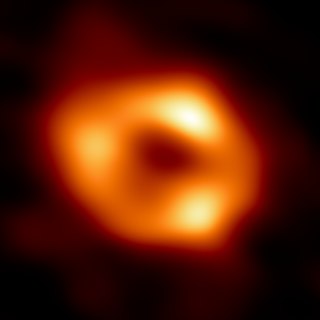
Sagittarius A*, abbreviated Sgr A*, is the supermassive black hole at the Galactic Center of the Milky Way. Viewed from Earth, it is located near the border of the constellations Sagittarius and Scorpius, about 5.6° south of the ecliptic, visually close to the Butterfly Cluster (M6) and Lambda Scorpii.

Radboud University (abbreviated as RU, Dutch: Radboud Universiteit, formerly Katholieke Universiteit Nijmegen) is a public research university located in Nijmegen, the Netherlands. The university bears the name of Saint Radboud, a 9th-century Dutch bishop who was known for his intellect and support of the underprivileged.

The Low-Frequency Array (LOFAR) is a large radio telescope, with an antenna network located mainly in the Netherlands, and spreading across 7 other European countries as of 2019. Originally designed and built by ASTRON, the Netherlands Institute for Radio Astronomy, it was first opened by Queen Beatrix of The Netherlands in 2010, and has since been operated on behalf of the International LOFAR Telescope (ILT) partnership by ASTRON.
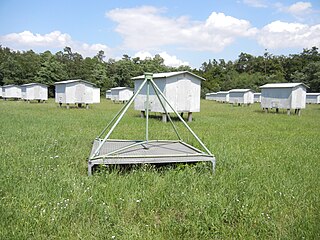
The LOPES project was a cosmic ray detector array, located in Karlsruhe, Germany, and is operated in coincidence with an existing, well calibrated air shower experiment called KASCADE. In 2013, after approximately 10 years of measurements, LOPES was finally switched off and dismantled.
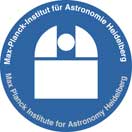
The Max-Planck-Institut für Astronomie is a research institute of the Max Planck Society (MPG). It is located in Heidelberg, Baden-Württemberg, Germany near the top of the Königstuhl, adjacent to the historic Landessternwarte Heidelberg-Königstuhl astronomical observatory. The institute primarily conducts basic research in the natural sciences in the field of astronomy.
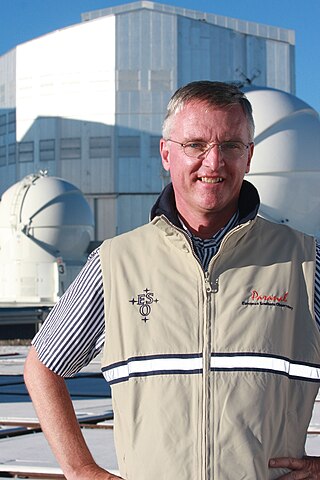
Pieter Timotheus "Tim" de Zeeuw is a Dutch astronomer specializing in the formation, structure and dynamics of galaxies. From 2007 to 2017 he was the director general of European Southern Observatory. He is married to astronomer Ewine van Dishoeck. In May 2022, Leiden University suspended him after an internal review concluded that over several years he repeatedly belittled and insulted women in public and abused his position of power as a professor by threatening to damage their scientific careers; and that in addition to intimidation and inappropriate behavior there was "a component of sexual harassment". The Max Planck Institute for Extraterrestrial Physics announced that they will no longer work with him and the European Southern Observatory banned him from accessing their premises.
The Event Horizon Telescope (EHT) is a large telescope array consisting of a global network of radio telescopes. The EHT project combines data from several very-long-baseline interferometry (VLBI) stations around Earth, which form a combined array with an angular resolution sufficient to observe objects the size of a supermassive black hole's event horizon. The project's observational targets include the two black holes with the largest angular diameter as observed from Earth: the black hole at the center of the supergiant elliptical galaxy Messier 87, and Sagittarius A* at the center of the Milky Way.

The Swedish-ESO Submillimetre Telescope (SEST) is a 15-metre diameter radio telescope. It was originally located at the La Silla Observatory in Chile, and will be moved to Africa and repurposed as the Africa Millimetre Telescope.
In astronomy, blitzars are a hypothetical type of neutron star, specifically pulsars that can rapidly collapse into black holes if their spinning slows down. Heino Falcke and Luciano Rezzolla proposed these stars in 2013 as an explanation for fast radio bursts.
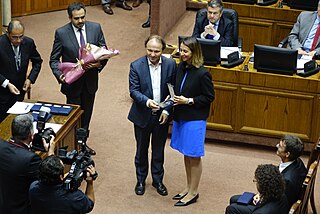
Violette Impellizzeri, is an Italian astronomer, astrophysicist and professor.

Luciano Rezzolla is an Italian professor of relativistic astrophysics and numerical relativity at the Goethe University Frankfurt. His main field of study is the physics and astrophysics of compact objects such as black holes and neutron stars. It was announced in 2019 that he had been appointed honorary Andrews Professor of Astronomy at Trinity College Dublin (TCD).
Samaya Michiko Nissanke is an astrophysicist, associate professor in gravitational wave and multi-messenger astrophysics and the spokesperson for the GRAPPA Centre for Excellence in Gravitation and Astroparticle Physics at the University of Amsterdam. She works on gravitational-wave astrophysics and has played a founding role in the emerging field of multi-messenger astronomy. She played a leading role in the discovery paper of the first binary neutron star merger, GW170817, seen in gravitational waves and electromagnetic radiation.
Sera Markoff is an American astrophysicist and full professor of theoretical high energy astrophysics at the Anton Pannekoek Institute for Astronomy, University of Amsterdam. She is a member of the Event Horizon Telescope team that produced the first image of a black hole.
Sheperd "Shep" S. Doeleman is an American astrophysicist. His research focuses on super massive black holes with sufficient resolution to directly observe the event horizon. He is a senior research fellow at the Center for Astrophysics | Harvard & Smithsonian and the Founding Director of the Event Horizon Telescope (EHT) project. He led the international team of researchers that produced the first directly observed image of a black hole.

Johann Anton Zensus is a German radio astronomer. He is director at the Max Planck Institute for Radio Astronomy (MPIfR) and honorary professor at the University of Cologne. He is chairman of the collaboration board of the Event Horizon Telescope (EHT). The collaboration announced the first image of a black hole in April 2019.
Eric Agol is an American astronomer and astrophysicist who was awarded a Guggenheim Fellowship in 2017.
The Netherlands Research School for Astronomy is a graduate school specializing in astronomy, based in the Netherlands. This graduate school was founded in 1992.
Monika Mościbrodzka is a Polish astrophysicist who is a professor at Radboud University Nijmegen. She is an expert in general relativistic plasma dynamics and numerical astrophysics. She was part of the Event Horizon Telescope team who contributed to the first direct image of a black hole, supermassive black hole M87*. She was awarded the 2022 Dutch Research Council Athena Prize and the 2023 Eddington Medal of the Royal Astronomical Society.
Mariëlle I. A. Stoelinga is a Dutch computer scientist based in the Netherlands. She is full professor of Risk Management for High Tech Systems in the Formal Methods & Tools Group at the University of Twente, Enschede, the Netherlands and holds a partial appointment as a full professor in the Software Science department at the Radboud University, Nijmegen. She is also director of Life Long Learning at the Faculty of Electrical Engineering, Mathematics and Computer Science, at the University of Twente.











